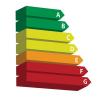AI for improved Energy Performance Certificates Reliability
Contributing to EPC being more reliable, user-friendly, cost-effective, better quality, and EU legislation-compliant.
Categories

What is the challenge that is being addressed?
Considering the vast room of improvement in the field of energy performance certification and the approach shift of the amending EPBD; there are plenty of possibilities for the adequate implementation a the more reliable, high quality and harmonised next generation of Energy Performance Assessment and Certification. It should contribute to generating trust and to boosting the energy refurbishment market. In this context, policy makers in charge of the Energy Performance Certificates (EPCs) implementation should contribute to boosting the generation of reliable and change-inducing EPCs; however, to this end it is paramount to improve the processes that revolve around EPCs and that can contribute to their accuracy and to increasing their reliability. This shift will require to work with real energy data (BAC/BEMS) and other data sources to characterise and contextualise the building stock (geometry, energy systems, weather, social aspects, etc). These improvements will contribute to supporting the EPC quality checking mechanisms deployed by certification authorities; thus, being able to further guarantee reliability and boost trust in Energy Performance Certification.
What is the AI solution the project plans to implement?
This pilot aims to integrate vast amounts of data in a harmonised way by means of scalable AI mechanisms, that are founded on a number of data characterising the building stock and its energy consumption, including cadastre, digital building twins coming from Pilot 0, and Energy Management Systems at Building or District level, invoices, and will demonstrate I-NERGY at two different levels. First, I-NERGY crossdomain analytics will serve to set EPC checking alarms for the certification authorities to adequately implement EPC quality assurance measures. In this line, the analytics will be tailored to detect patterns from real energy consumption data, distinguishing among the consumption derived from the energy fabric, energy systems and user behaviour. This will be contrasted to existing EPCs and raise alarms when AI inferred energy values greatly differ from existing EPCs. Secondly, cross-domain predictive and prescriptive analytics will provide support to predict the optimal building energy retrofitting planning dates, based on the abovementioned analytics.
This will contribute to EPC being more reliable, user-friendly, cost-effective, better quality, and EU legislation-compliant, while contributing to remove ‘reliability’ barriers which are actually hindering the high potential of EPCs to realise significant energy efficiency in the building sector. Consequently, the ex EPC usage would be increased across Europe and end-users. Using the Smart Readiness Indicator, several aspects will take into consideration in the EPC calculation method, such as: optimised energy use, diagnosis, improved comfort, adaptation in response to users and response to grid.
Who will help implement this solution?
This pilot is implemented within the framework of the “I-NΕRGΥ: Artificial Intelligence for Next Generation Energy” Project. The I-NERGY Project has received funding from the European Union's Horizon 2020 Research and Innovation programme under grant agreement No. 101016508.
The responsible partner for this Use Case is FAEN (https://www.faen.es/).
Learn more about I-NERGY pilots here: https://i-nergy.eu/pilots
